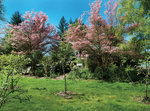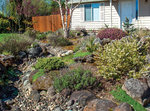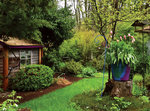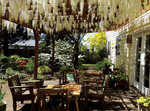



Wander through 12 blooming backyards showcasing earth-friendly techniques from 10 a.m. to 4 p.m. Sunday during the Natural Garden Tour of Clark County.
“This is a great opportunity to see firsthand the astonishing results gardeners can achieve without using chemicals that can harm people, pets and wildlife,” said Clark County Public Health Environmental Program Coordinator Sally Fisher.
Clark County Green Neighbors provides details on each of the dozen stops along the tour. Four of the gardens are located in Battle Ground, Brush Prairie and La Center. For more information, visit clarkgreenneighbors.org/gardentour.
Half Moon Farms, 14737 NE 159th Street., Brush Prairie
This sustainable farm by Bob and Brenda Calvert features naturally raised honey and mason bees, as well as heritage chickens and many heirloom fruit and vegetable varieties. Rainwater is collected for irrigation. A koi pond with a sand biofiltration system and aquaponics garden creates a relationship between fish and water celery.
Linda Kliewer, 201 NW 19th Street., Battle Ground
In the midst of suburbia, this yard is a lush paradise of unique perennials, trees and flowers that work well in the saturated, anaerobic soil that comes with the nearby wetland. Working with the wetland can be challenging, but Kliewer has a well and ground septic system that keeps the water cycling within the local area. The wild landscape she has created is more than a home for wildlife, it is a work of art. Step into Kliewer’s studio and admire the pottery designs inspired by her garden and see the brilliant orchids and hibiscus in the greenhouse.
Bob Manelis, 805 NW 17th Circle in Battle Ground
When this neighborhood was built, wetlands were filled with stones and truckloads of soils from construction sites to raise the land for building. Manelis has done a lot of experimenting to see what will grow on this property. The most prominent feature of his garden is the 32 tons of salvaged igneous boulders composing walls, path liners, a dry creek bed and sitting areas. A variety of flowering plants accent the garden throughout the year with varieties of heath, heather, Hebe and a lawn of steppable thyme.
Dutch Acres, 36009 NE 31st Avenue, La Center
Charles Van Amerongen planted more than 200 trees including spruce, flowering and fruit trees growing in volcanic ash found on Mount Rainier. Among the diversity of species, take note of the giant lily that only blooms every seven years and can reach up to six feet tall. He manages pests and weeds with a variety of organic sprays, diatomaceous earth, mulching and homemade solutions, such as castor oil and soap to deter moles. Brush piles around the property provide habitat for wildlife, and the many flowering plants attract pollinators. At the back of the property, a stream meanders through a meadow at the edge of the forest.
Patty and David Page, 1209 NW Lakeview Road, Vancouver
The Pages are devoted to clean water practices and retain their water on site with rain gardens, rain barrels, rain chains and downspout irrigation. Ten fruit trees including columnar and espaliered apple trees, eight berry varieties, artichokes and other fruits including a kiwi vine make this garden a cornucopia of perennial foods among the artistically terraced landscape.
Wanda Wilson, 1716 100th Street, Vancouver
Wilson maintains her garden with compost, leaf and hazelnut mulch and by hand-pulling weeds. The front yard is a terraced slope of flowers and trees, including a clerodendrum – nicknamed the peanut butter tree for the scent of its leaves. A single planted acorn has grown into a towering sawtooth oak amongst a hosta and fern garden.
Gregg Andrews, 11309 NW 21 Avenue, Vancouver
Relax in the Zen garden – an enclosed, roofless patio lined with bamboo. Listen to the buzz of bees among the various fruit gardens near the hive. Andrews has been planting, building, and pulling weeds for 38 years. He uses organic neem oil to treat leaf curl on the peach trees, but otherwise, he has deliberately planted resilient, low-maintenance species.
Diana Chemofsky, 13629 NW 43rd Avenue, Vancouver
Chemofsky’s yard encapsulates her dream of living in an edible landscape coexisting with wildlife. The property is abundant with birds and bees and has been certified as a Wildlife Habitat through the National Wildlife Federation. All rainfall is captured by the ground and bioswales. Salvaged stumps and wood chips provide habitat and erosion control.
The Humming Garden, 15007 NE 48th Street., Vancouver
“I fell in love with natural gardening practices and added elements to our garden to make it an oasis for our local wildlife and insects as well as Barnaby, our 220-pound Great Dane,” stated Laura Heldreth. She coaches students in the Master Gardener Program at Clark College and shares tips on her blog, The Humming Gardener.
Pam and Marty Almandinger, 10105 NE 98th Avenue., Vancouver
This urban backyard is home to a variety of wildlife and plants from towering cedars to shady ground covers and raised veggie gardens. A pond with a waterfall ripples peacefully among the twitter of birds and the hum of pollinators. The Almandinger’s use vinegar and salt to kill weeds growing on the paths and slug traps full of beer to lure and drown the pests.
Shangri-La Farm, 26300 NE Third Street., Camas
Liz Pike has packed her two acres with a variety of animals, plants and structures made from reclaimed materials. She uses an outdoor canning kitchen for abundant berries and orchard fruits grown on her farm. The chickens eat pests and their manure acts as fertilizer. Honey, eggs and produce are sold from an honor-system farm stand.
Janice Ferguson and George Gross, 769 K Street in Washougal
Ferguson and Gross turned their property into a natural oasis on the Washougal River. Native plants on the shoreline provide shelter and food for wildlife and reduce erosion. Native ginger, horse mint, hostas, ferns and Oregon grape are among more than 20 species of native plants along the landscape.